Chapter 18. Young Star Clusters
18.1 Introduction

Author: Kristen Miller
Editor: Grace L. Deming, University of Maryland
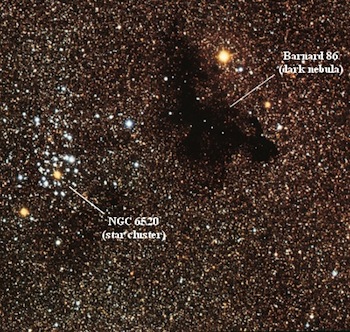
The goals of this module: After completing this exercise, you should be able to:
- Describe the environment in which star formation occurs.
- Explain how mass affects the time a star spends in each phase of its evolution.
- Use an Hertzsprung-Russell (H-R) diagram to determine the age of a given star cluster.
In this module you will explore:
- How the presence of high mass stars in a cluster affects the evolution of all of the other cluster member stars.
- How the H-R diagram of a cluster can be used to determine its age.
Why you are doing it: Star clusters provide a rich environment for studying the process of star formation. They allow us to glimpse the differences between high and low mass stars as they form and study how these stars can affect each other. The H-R diagram gives us an easy way to determine cluster ages, which would otherwise be very difficult to measure. Understanding how to interpret the information presented in the H-R Diagram of a star cluster helps us better understand how stars form.
18.2 Background
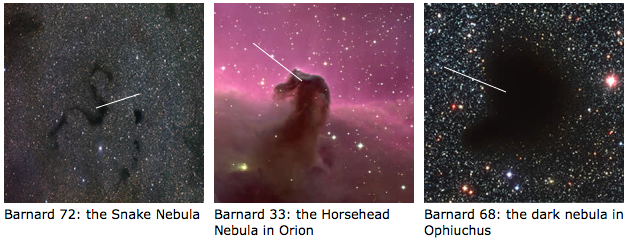
Stars form in dark, cold areas of the galaxy known as dark nebulae. A dark nebula is a cold (around 10 Kelvin at the center!) cloud of gas and dust containing tens to hundreds of solar masses of material in a volume of space roughly 1-10 parsecs across. These nebulae have very high densities compared to the average density of the interstellar medium and can be almost any shape, as you can see in the pictures above! Their high densities and low temperatures make them ideal spots for star formation to occur.
Star formation begins when the dark nebula is squeezed by some source that triggers the gravitational collapse of the cloud. Triggers come in many forms: 1) The powerful explusions of hot, young O and B stars compress the cold material of the clouds they form in, triggering the next generation of star formation. 2) The explosive death of a massive star, known as a supernova, sends shock waves traveling through the interstellar medium. When these shock waves collide with a dark nebula, they compress it and trigger the collapse of the cloud. 3) Simply by passing through the spiral arms of the galaxy itself can shock, or compress suddenly, the cold gas and dust of the nebula and lead to a new cycle of star formation. Once the collapse has begun, the contracting cloud repeatedly splits into smaller, individually contracting fragments due to internal instabilities brought on by the collapse itself. Each of these fragments will eventually become a single star. This means that a single trigger can give rise to the simultaneous birth of many stars, which form a star cluster.
In this activity, you will explore how stars in a cluster evolve and how the HR diagram of a cluster allows us to glean valuable information about the individual clusters themselves and the star formation process in general.
18.3 The Same, Yet Different
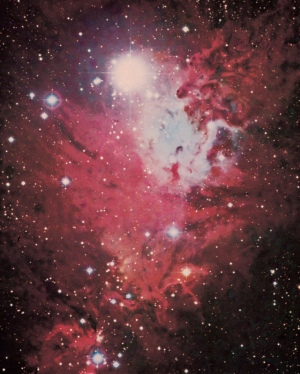
Stars in a single cluster form at roughly the same time (the time that the collapse of the parent nebula was initiated); this means that all of the stars in a cluster are roughly the same age. Since they all formed out of the same cloud, they all have the same initial composition. However, these forming stars differ in one very important way: their masses!!
The more massive a protostar is, the quicker it reaches the interior pressure and temperature needed to begin hydrogen fusion, and thus the quicker it reaches the main sequence. This trend continues after protostars reach the main sequence as well: more massive stars use their existing fuel more rapidly than low mass stars and therefore have shorter main sequence lifetimes. Massive stars are like the brilliance of a fireworks display - incredibly bright and beautiful, but fleeting - while low mass stars may be compared to the quiet, enduring flame of a candle.
Question 18.1
YK2p3ew9Ntfxbyw5NAGBDYw4+7/OVmiFJvsSe9lvjMvFMpBko3tYpvuli92F3mvLr3VNKDjSqISHYL7I6Nr00efKpvBMqBKk17JlbEy0O9peVP2+2XGvzTJiHb6zOSxUFF7DFK6vu7DrlmoDa7CivbilOQhcPACChKIKFjLz9KKX95OqD1tcTKFWJBAXKYIHEBWfSZwyW+VbGAc7pqjq45nBZ9gRZDkCEf/JcXqyv61LYCARStW4O3DbpRqVbX5KXmD71TxqM87UBL4BEDNY9+ddFIlGLrviCR1y6ALVnH0glo3+F6OkhEDRMC78X7tvZ9GsxxITGsdvUG/8e/uEspvsDMhLrNOhcRxLtvE+u/YJJ85ibchOiPyKV8CT2iA8txbualryUJi2gfcAjiMmknYzvAdIOCMHY0LDrlDod3MaKnuimkHUeoI5Vg2Aw9pkGpBeIA==18.4 The Role of High Mass Stars
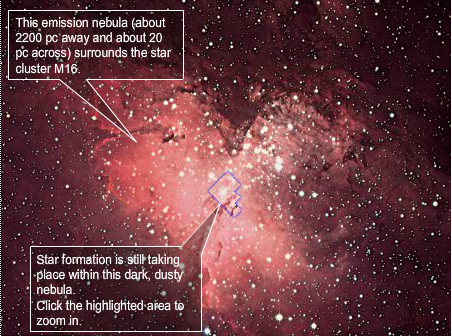
Once high mass protostars reach the main-sequence, they become hot, bright O and B stars. This is an important step in the evolution of the cluster, because O and B stars produce significant changes in their environment that strongly affect the subsequent evolution of the remaining protostars!
Because they are very hot, O and B stars emit huge amounts of ultraviolet (UV) radiation, which ionizes the gas in the nebula and creates beautiful HII regions, as seen in the figure below. However, this intense UV radiation also eats away at the dusty cocoons which surround nearby forming protostars, prematurely ending the accretion phase of their formation and thus limiting the main sequence mass each will attain.
Some star clusters are known as open clusters because they barely have enough mass to hold the cluster together gravitationally; other clusters, which are held securely together by gravity, are called bound. All stars, including stars in clusters, move in space. In a bound cluster, the speed needed to escape from the cluster's gravity - known as the escape velocity - is easily high enough to keep the gas and the fastest stars in the cluster from escaping. In an open cluster, however, the escape velocity is often just barely larger than the speeds of the cluster's fastest stars. Once the gas in an open cluster becomes heated and ionized by O and B stars, it cannot be held by the cluster's gravity and it escapes. Ironically, the loss of its gas almost always leaves an open cluster with too little mass to remain bound. This occurs because the cluster's escape velocity decreases as the mass of the cluster decreases. In an open cluster, only a small decrease in escape velocity is enough to allow the fastest stars to escape, further decreasing the cluster's mass and escape velocity. The cycle continues until the cluster has dispersed completely. Thus, O and B stars disrupt the formation of stars within a cluster, the gas out of which the cluster forms, and the cluster itself!! These O and B stars are truly a dominant force in the evolution of a star forming region.
Question 18.2
7qipMS2EJz/TAlZ8JbKaL3eHrBh8ojprJV4dQ4nZGeRtXR+KgirXo6UXPCSLNIzJbxNfQyONvfmIEQab69iJf9qMUzFrtPvU5+pHxKNcy6CSFW3mIKsBJSioBy7z/ekgd2gspe1xMOSNxUQgmxXOauDv1KitnUNiFxbtYv8c4dsC96m+US9GChbtysYpwHvhaGBn8hQgQ3KEkRWGeMVPYYWFaYRncPVJsEQUJTmfJ7330sHjFQNDet/8LP8iYLHv3xXuZvT7tNPl/EOlXk/TkpS0jrcoGFuZPVSNFGo1guMqzsjLppSGya2saJ6ZvdKl7/KoXX14b9m8f8es+G30t3YivQMorAL/+abSnX1H98azlVnyAGSirnrShgqxAIQQftUnZAPXoK6oIUEsTNJ4q3eJNQ3xjD49O/iHsUPowImAsN1aBTjkXp2KtqDL4nYyIW4QY5Wc00TRVRYR4dtwV5RSFVSwMYHc80Dmnmv6LFb5wUyk4t6fHB6LdZHL8HpcW5Q2GHjrb/7GruSlTH2Etv56pcnqnI9fJGtzskyuAt/ouiZ57bxVpCEewxuFrOEcPWcoSj2dZJoBuBrV9NRy80JQ5N4gBE/WtGyx7cHIzl7U0gSZa0AquyxvPvbCQYAYb0epl+RZ1jflqs7A+EHdCgAphY17vZc2MZK8nOS4QYJjZPPvjJc59Oh/EzlufJvgiOpQoSC9BAKiub7gCnEYHwJvhmEQ4kR+pHi25t5RSLq93cKnyb+xEDAvsvrqCKT7R4nXRjJBBtgbHOxfqjkyUNmjb26MmlMLJyEUgU3stdzdcMzWsNHNNab3Fz2gpEIJxbTteiE7/v/oQOERbQAoYSlC8JHzojNzhd/VdyNBM5N+EH/I+EuYhIaW7Q6qE+OC18.5 The H-R Diagram and Age
The H-R diagram provides a visual way of summarizing what we have learned about star birth in clusters. We can see this by looking at an H-R diagram of a typical open cluster.
In the figure, we can clearly see that the hot, bright, high mass stars have reached the main sequence, while the cold, dim, low mass stars are still forming. This is exactly what we would expect of a very young cluster, and in fact NGC2264 is only a few million years old – very young in terms of star formation!
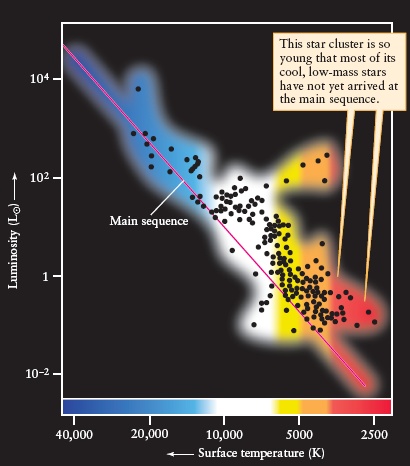
In fact, astronomers use cluster H-R diagrams to accurately determine the ages of star clusters. They do this by determining the location of the main sequence turnoff point. The main sequence turnoff point is the spectral type of the stars that are just leaving the main sequence. This is shown in the H-R diagram below:

The high mass stars in this cluster have already ended their main sequence lives and are evolving to become giants. The turnoff point occurs at about spectral type B. According to the chart below, if the stars of spectral type B are evolving off the main sequence, then the cluster must be about 15 million years old. This is because B stars live for 15 million years on the main sequence, so those stars evolving off are 15 million years old. Because all of the stars in a cluster are born at roughly the same time, all of the stars must be 15 million years old and thus the cluster itself is 15 million years old.
| Turnoff Point | Age |
|---|---|
| O | 4 x 106 |
| B | 15 x 106 |
| A | 8 x 108 |
| F | 4.5 x 109 |
| G | 12 x 109 |
| K | 25 x 109 |
| M | 7 x 1011 |
The animation below shows how the H-R diagram changes as a given cluster ages.

Now that you have a feel for how the H-R diagram looks for a cluster of a given age, see if you can determine the ages of the following clusters.
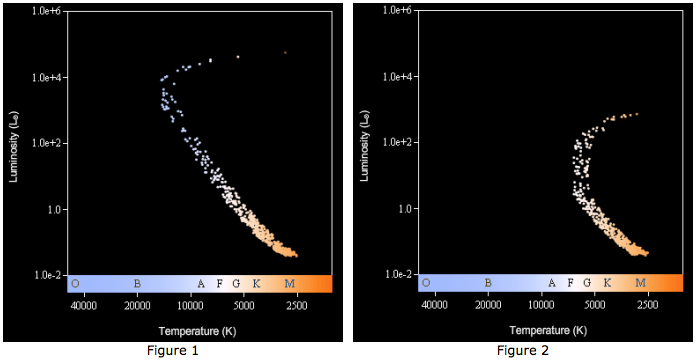
Question Sequence
Question 18.3
6IhvIryFpHyDEme7kxazfdNmRf7pnT1B8BtwwBTNCfWOrYt0COzKhL37tcBFZq1BqhOygB6g29hX2nrXJNQk6dgwqhGYFDxBc8E8QVly/mBEyI+SKStL7HiXgKo4FW14yS1qLrzrLEZ0KQh9dKZF5NCwDrQsQ7O4u59BHyKtPT4+FPMC1UyPsoJjPZ2tIn8j3LjVaOCSQ0EQ7YWdL+m+R5CuMLS2RcNkfMQV5vUCLtM=Question 18.4
9JiHl9HgQe7QabDQfSYR0XJG5NPjrk7d+fnhX+LcKZ2yLxVr5u0GZHvLqQmGcxkGizyPK/bLTTDKCaJaC7llotL6MkMInIWlPwK/qJo4ymk/Yd3wO84SzJYmRjfBwyTmsaooiMrzwaN3zooJ7m5zhlPVgbm0zBVGF2klm46iaNUPJpVIaDV0+jmGnD1IGdUs20ce9nBB3E9zOo9lplQEzNSKZKg+kTp/MBMmDjoX6wA=Question 18.5
PMJsDt9IBuCoJYPAmJoZkL8jMjhDiKlYxwK4DZezg6CG9DKlJtufARqvT7nyHe7uBPDDmi+xz0tfbaOEy4bcAXaVKa91k1z3dWlhaWKBa6u+s4hxkgZIJlZ8tPWIqMiaCE90pMVThLQiKjnibOGO7iouLydf8EwHWYsR7qz/z2xkkGy7SdyClyYLBjCEyxAyoJa2Nm8TKTDNjvoiHD5ha1UhfEpS/I98DxLQPWu4lWYkkWpByBDN+g==18.6 Quick Check Quiz
Indepth Activity: Young Star Clusters